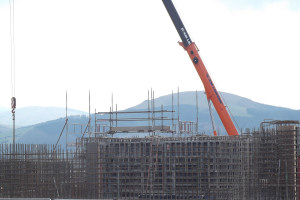Dalton Cumbrian Facility building well under way
07 Apr 2011
The Dalton Nuclear Institute’s £20m investment in a new research facility in West Cumbria will aim to answer some of the pressing questions in the field of radiation science and nuclear waste management.

The Dalton Cumbrian Facility (DCF) will open in October to deliver world-leading research in radiation science, nuclear engineering decommissioning and radioactive waste management.
Part of The University of Manchester, it will provide a unique resource for both academia and industry, giving access to the National Nuclear Laboratory’s faculties and allowing academics to conduct research and experiments with radioactive materials, as well as developing and demonstrating engineering prototypes.
Professor Andrew Sherry, Executive Director of the Dalton Nuclear Institute, believes that the Cumbrian Facility has an obligation to provide high-quality individuals to feed into the burgeoning global industry.
He said: “Nuclear has some big challenges; how do you operate a plant safely, and how do we understand how a plant changes during its lifetime? What about nuclear waste, managing that waste, reducing its volume and storing it safely?
“We hope to solve some of theses problems, and will provide solutions to help move things forward.
“DCF incorporates an environment for delivering world-leading research through its extensive experimental, computer modelling and analytical capability, as well as providing the University with a facility that is unique in Europe. The link between application and research is crucial for us.”
At the heart of DCF are extensive irradiation faculties, including a 5MV ion-beam accelerator and a self-shielded co-irradiator.
Professor Simon Pimblott, DCF Research Director, was recruited from The University of Notre Dame, Indiana, USA.
Speaking about the work he will be carrying out in Cumbria, he said: “We want to understand the mechanisms of what occurs when you irradiate a material.
“We’ll take that knowledge and apply it so you can get some kind of prediction about what’s going to happen in terms of long-term degradation and performance of a material in a real environment.
“Empirical understanding of what’s going on, simply by looking at something, is not acceptable. Not to me. At our Cumbrian facility it will be pure, solid, world-leading fundamental science.”
With the pile drive and ground work already underway in West Cumbria, Professor Pimblott is excited about the research he has to undertake, and says he can already envisage more work than he can do before he retires.
He added: “Everything is really pushing ahead at a fast pace – we have the building going up, we have the facility and the equipment to go inside it.
“And it looks like come October we will be beginning to deliver the bottom line – which is what you always want to do.”
